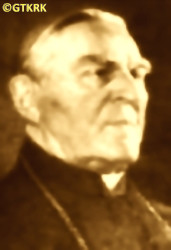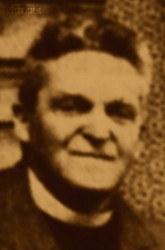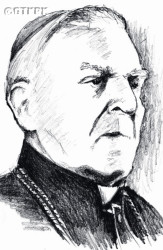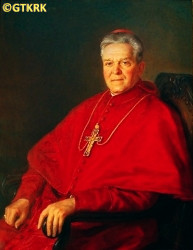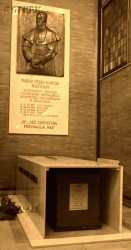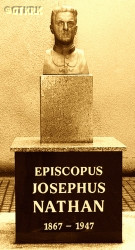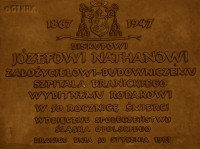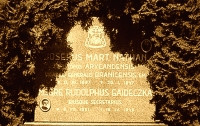Roman Catholic
St Sigismund parish
05-507 Słomczyn
85 Wiślana Str.
Konstancin deanery
Warsaw archdiocese, Poland
full list:
displayClick to display full list

searchClick to search full list by categories
wyświetlKliknij by wyświetlić pełną listę po polsku

szukajKliknij by przeszukać listę wg kategorii po polsku

Martyrology of the clergy — Poland
XX century (1914 – 1989)
personal data
surname
NATHAN
forename(s)
Joseph Martin (pl. Józef Marcin)
function
bishop
creed
Latin (Roman Catholic) Church RCmore on
en.wikipedia.org
[access: 2014.09.21]
diocese / province
Olomouc archdiocesemore on
en.wikipedia.org
[access: 2014.10.31]
honorary titles
protonotary apostolicmore on
en.wikipedia.org
[access: 2014.11.22]
(1926)
pontifical prelatemore on
en.wikipedia.org
[access: 2014.11.14]
(1924)
date and place
of death
30.01.1947

OpavaChech Silesia
today: Opava dist., Moravian‐Silesian reg., Czechia
more on
en.wikipedia.org
[access: 2022.08.05]
details of death
After national–socialist NSDAP party took power in Germany in 1933 and during World War II, which began with the German and Russian invasion of Poland in 09.1939, secretly sent liturgical vessels and vestments to the German concentration camp KL Dachau, where i.a. c. 1,500 Polish Catholic priests were kept captive.
From 1941, when the Germans transported several hundred mentally ill from the facility in Branice to the sites of the genocidal Operation T4 (ostentatiously „to other care facilities”) — i.a. do TA Sonnenstein euthanasia center — and murdered them, defended the remaining patients in their institutions.
Recognized by the Germ. Geheime Staatspolizei (Eng. Secret State Police), i.e. Gestapo, from Opava as Lat. persona non grata (Eng. undesirable person).
In 09.1945, after the German defeat in World War II, removed by the Primate of Poland, August Cardinal Hlond, from administrative responsibility for Branice and part of the Olomouc archbishopric, which came under the control of the prl — the Polish Russian Republic.
On 21.12.1946 forcibly deported from his seat in Branice by Commie‐Nazi UB, Polish unit of Russian NKVD, to Czech Rep.
There soon perished in the hospital.
cause of death
exile
perpetrators
Russians / Poles
sites and events
TA SonnensteinClick to display the description, «Aktion T4»Click to display the description, KL DachauClick to display the description, Ribbentrop‐MolotovClick to display the description, Pius XI's encyclicalsClick to display the description
date and place
of birth
11.11.1867

Tłustomostytoday: Baborów gm., Głubczyce pov., Opole voiv., Poland
more on
en.wikipedia.org
[access: 2022.01.28]
parents
NATHAN Joseph
🞲 ?, ? — 🕆 ?, ?

ODERSKY Antonia
🞲 ?, ? — 🕆 ?, ?
presbyter (holy orders)
ordination
23.06.1891

Wrocławtoday: Wrocław city pov., Lower Silesia voiv., Poland
more on
en.wikipedia.org
[access: 2021.04.02]
positions held
1943 – 1947
titular bishop — Arycanda RC diocese — appointment: on 17.04.1943; ordination: on 06.06.1943, in Branice
1943 – 1947
auxiliary bishop (Lat. episcopus auxiliaris) — Olomouc RC archdiocese — appointment: on 17.04.1943
1938 – 1943
vicar general — Sudetenland — with bishop's rights
1924 – 1943
vicar general — Kietrz's Commissariat i.e. part of the Olomouc diocese within Germany — with bishop's rights; also: founder of new church in Branice
1916 – 1924
Archbishop's Commissioner — Kietrz's Commissariat i.e. part of the Olomouc diocese within Germany
1913 – 1916
parliamentary deputy — Berlintoday: Berlin state, Germany
more on
en.wikipedia.org
[access: 2020.07.31] ⋄ Reichstag i.e. German Parliament
from 1904
founder and chairman — Branicetoday: Branice gm., Głubczyce pov., Opole voiv., Poland
more on
en.wikipedia.org
[access: 2021.04.02] ⋄ Foundation for the treatment and care of mentally ill — supervised creation of 26 hospital facilities
from 1900
founder — Branicetoday: Branice gm., Głubczyce pov., Opole voiv., Poland
more on
en.wikipedia.org
[access: 2021.04.02] ⋄ Institute of Treatment and Care (Germ. Branitzer Heil– und Pflegeanstalt) for the mentally ill
1899 – 1945
parish priest — Branicetoday: Branice gm., Głubczyce pov., Opole voiv., Poland
more on
en.wikipedia.org
[access: 2021.04.02] ⋄ Assumption of the Blessed Virgin Mary RC parish — also: founder of churches in Michałkowice and Boboluszki
1892 – 1899
vicar — Branicetoday: Branice gm., Głubczyce pov., Opole voiv., Poland
more on
en.wikipedia.org
[access: 2021.04.02] ⋄ Assumption of the Blessed Virgin Mary RC parish — also: church founder in Wysoka
1891 – 1892
vicar — Zawiszycetoday: Głubczyce gm., Głubczyce pov., Opole voiv., Poland
more on
en.wikipedia.org
[access: 2022.04.12] ⋄ St Mary Magdalene RC parish
1888 – 1891
student — Wrocławtoday: Wrocław city pov., Lower Silesia voiv., Poland
more on
en.wikipedia.org
[access: 2021.04.02] ⋄ philosophy and theology, Theological Seminary
1887 – 1888
student — Freiburg im Breisgautoday: Freiburg im Breisgau urban dist., Freiburg reg., Baden‐Württemberg state, Germany
more on
en.wikipedia.org
[access: 2020.07.31] ⋄ philosophy and theology, Theological Seminary
sites and events
descriptions
TA Sonnenstein: From 06.1940 to 09.1942, in Sonnenstein castle, the Germ. NS‐Tötungsanstalt (Eng. National Socialist Extermination Center), i.e. TA Sonnenstein, operated. As part of «Aktion T4», program approx. 15,000 people — mostly mentally and mentally ill, but also prisoners of concentration camps, mainly from Saxony, Thuringia, Silesia and East Prussia — were murdered by the Germans in a gas chamber. After „examination”, the victims were forced to undress, and then, in groups of 20‐30 were taken to a cell‐room under the pretext of having to take a bath. The room was equipped with nozzles simulating shower heads. After closing the steel door, a German „doctor” opened the container with carbon monoxide and let it into the chamber. Death took place — closely watched by the camp staff — within 20‐30 minutes. (more on: pl.wikipedia.orgClick to attempt to display webpage
[access: 2012.11.23])
«Aktion T4»: German state euthanasia program, systematic murder of people mentally retarded, chronically, mentally and neurologically ill — „elimination of live not worth living” (Germ. „Vernichtung von lebensunwertem Leben”). At a peak, in 1940‐1941, c. 70,000 people were murdered, including patients of psychiatric hospitals in German occupied Poland — German formalists noted then that, among others, „performing disinfection [i.e. gassing] of 70,273 people with a life expectancy of up to 10 years saved food in the amount of 141,775,573.80 Deutschmark”. From 04.1941 also mentally ill and „disabled” (i.e. unable to work) prisoners held in German concentration camps were included in the program — denoted then as «Aktion 14 f 13». C. 20,000 inmates were then murdered, including Polish Catholic priests held in KL Dachau concentration camp, who were murdered in Hartheim gas chambers. The other „regional extension” of «Aktion T4» was «Aktion Brandt» program during which Germans murdered chronically ill patients in order to make space for wounded soldiers. It is estimated that at least 30,000 were murdered in this program. (more on: en.wikipedia.orgClick to attempt to display webpage
[access: 2014.10.31])
KL Dachau: KL Dachau in German Bavaria, set up in 1933, became the main German Germ. Konzentrationslager (Eng. concentration camp) KL for Catholic priests and religious during World War II: On c. 09.11.1940, Reichsführer‐SS Heinrich Himmler, head of the SS, Gestapo and German police, as a result of the Vatican's intervention, decided to transfer all clergymen detained in various concentration camps to KL Dachau camp. The first major transports took place on 08.12.1940. In KL Dachau Germans held approx. 3,000 priests, including 1,800 Poles. The priests were forced to slave labor in the Germ. „Die Plantage” — the largest herb garden in Europe, managed by the genocidal SS, consisting of many greenhouses, laboratory buildings and arable land, where experiments with new natural medicines were conducted — for many hours, without breaks, without protective clothing, no food. They slaved in construction, e.g. of camp's crematorium. In the barracks ruled hunger, freezing cold in the winter and suffocating heat during the summer, especially acute in 1941‐1942. Prisoners suffered from bouts of illnesses, including tuberculosis. Many were victims of murderous „medical experiments” — in 11.1942 c. 20 were given phlegmon injections; in 07.1942 to 05.1944 c. 120 were used by for malaria experiments. More than 750 Polish clerics where murdered by the Germans, some brought to TA Hartheim euthanasia centre set up in Schloss Hartheim in Austria and murdered in gas chambers. At its peak KL Dachau concentration camps’ system had nearly 100 slave labour sub‐camps located throughout southern Germany and Austria. There were c. 32,000 documented deaths at the camp, and thousands perished without a trace. C. 10,000 of the 30,000 inmates were found sick at the time of liberation, on 29.04.1945, by the USA troops… (more on: www.kz-gedenkstaette-dachau.deClick to attempt to display webpage
[access: 2013.08.10], en.wikipedia.orgClick to attempt to display webpage
[access: 2016.05.30])
Ribbentrop‐Molotov: Genocidal Russian‐German alliance pact between Russian leader Joseph Stalin and German leader Adolf Hitler signed on 23.08.1939 in Moscow by respective foreign ministers, Mr. Vyacheslav Molotov for Russia and Joachim von Ribbentrop for Germany. The pact sanctioned and was the direct cause of joint Russian and German invasion of Poland and the outbreak of the World War II in 09.1939. In a political sense, the pact was an attempt to restore the status quo ante before 1914, with one exception, namely the „commercial” exchange of the so‐called „Kingdom of Poland”, which in 1914 was part of the Russian Empire, fore Eastern Galicia (today's western Ukraine), in 1914 belonging to the Austro‐Hungarian Empire. Galicia, including Lviv, was to be taken over by the Russians, the „Kingdom of Poland” — under the name of the General Governorate — Germany. The resultant „war was one of the greatest calamities and dramas of humanity in history, for two atheistic and anti‐Christian ideologies — national and international socialism — rejected God and His fifth Decalogue commandment: Thou shall not kill!” (Abp Stanislav Gądecki, 01.09.2019). The decisions taken — backed up by the betrayal of the formal allies of Poland, France and Germany, which on 12.09.1939, at a joint conference in Abbeville, decided not to provide aid to attacked Poland and not to take military action against Germany (a clear breach of treaty obligations with Poland) — were on 28.09.1939 slightly altered and made more precise when a treaty on „German‐Russian boundaries and friendship” was agreed by the same murderous signatories. One of its findings was establishment of spheres of influence in Central and Eastern Europe and in consequence IV partition of Poland. In one of its secret annexes agreed, that: „the Signatories will not tolerate on its respective territories any Polish propaganda that affects the territory of the other Side. On their respective territories they will suppress all such propaganda and inform each other of the measures taken to accomplish it”. The agreements resulted in a series of meeting between two genocidal organization representing both sides — German Gestapo and Russian NKVD when coordination of efforts to exterminate Polish intelligentsia and Polish leading classes (in Germany called «Intelligenzaktion», in Russia took the form of Katyń massacres) where discussed. Resulted in deaths of hundreds of thousands of Polish intelligentsia, including thousands of priests presented here, and tens of millions of ordinary people,. The results of this Russian‐German pact lasted till 1989 and are still in evidence even today. (more on: en.wikipedia.orgClick to attempt to display webpage
[access: 2015.09.30])
Pius XI's encyclicals: Facing the creation of two totalitarian systems in Europe, which seemed to compete with each other, though there were more similarities than contradictions between them, Pope Pius XI issued in 03.1937 (within 5 days) two encyclicals. In the „Mit brennender Sorge” (Eng. „With Burning Concern”) published on 14.03.1938, condemned the national socialism prevailing in Germany. The Pope wrote: „Whoever, following the old Germanic‐pre‐Christian beliefs, puts various impersonal fate in the place of a personal God, denies the wisdom of God and Providence […], whoever exalts earthly values: race or nation, or state, or state system, representatives of state power or other fundamental values of human society, […] and makes them the highest standard of all values, including religious ones, and idolizes them, this one […] is far from true faith in God and from a worldview corresponding to such faith”. On 19.03.1937, published „Divini Redemptoris” (Eng. „Divine Redeemer”), in which criticized Russian communism, dialectical materialism and the class struggle theory. The Pope wrote: „Communism deprives man of freedom, and therefore the spiritual basis of all life norms. It deprives the human person of all his dignity and any moral support with which he could resist the onslaught of blind passions […] This is the new gospel that Bolshevik and godless communism preaches as a message of salvation and redemption of humanity”… Pius XI demanded that the established human law be subjected to the natural law of God , recommended the implementation of the ideal of a Christian state and society, and called on Catholics to resist. Two years later, National Socialist Germany and Communist Russia came together and started World War II. (more on: www.vatican.vaClick to attempt to display webpage
[access: 2023.05.28], www.vatican.vaClick to attempt to display webpage
[access: 2023.05.28])
sources
personal:
pl.wikipedia.orgClick to attempt to display webpage
[access: 2014.11.28]
bibliographical:
„Catholic Church in Głubczyce region in 1742‐1945”, Catherine Maler, vol. I and II, with erratum
original images:
sbc.org.plClick to attempt to display webpage
[access: 2019.10.13], docplayer.plClick to attempt to display webpage
[access: 2018.02.15], commons.wikimedia.orgClick to attempt to display webpage
[access: 2019.10.13], www.raciborz.com.plClick to attempt to display webpage
[access: 2014.11.28], jankowice.rybnik.plClick to attempt to display webpage
[access: 2014.11.28], jankowice.rybnik.plClick to attempt to display webpage
[access: 2014.11.28], jankowice.rybnik.plClick to attempt to display webpage
[access: 2014.11.28]
LETTER to CUSTODIAN/ADMINISTRATOR
If you have an Email client on your communicator/computer — such as Mozilla Thunderbird, Windows Mail or Microsoft Outlook, described at WikipediaPatrz:
en.wikipedia.org, among others — try the link below, please:
LETTER to CUSTODIAN/ADMINISTRATORClick and try to call your own Email client
If however you do not run such a client or the above link is not active please send an email to the Custodian/Administrator using your account — in your customary email/correspondence engine — at the following address:

giving the following as the subject:
MARTYROLOGY: NATHAN Joseph Martin
To return to the biography press below:
 Click to return to biography
Click to return to biography








